Perfect Vanilla Butter Cake
This is the only Vanilla Butter Cake recipe you’ll ever want or need. Mixing technique can make a big difference when making cake batter. Find out the best way to get a light and tender cake.
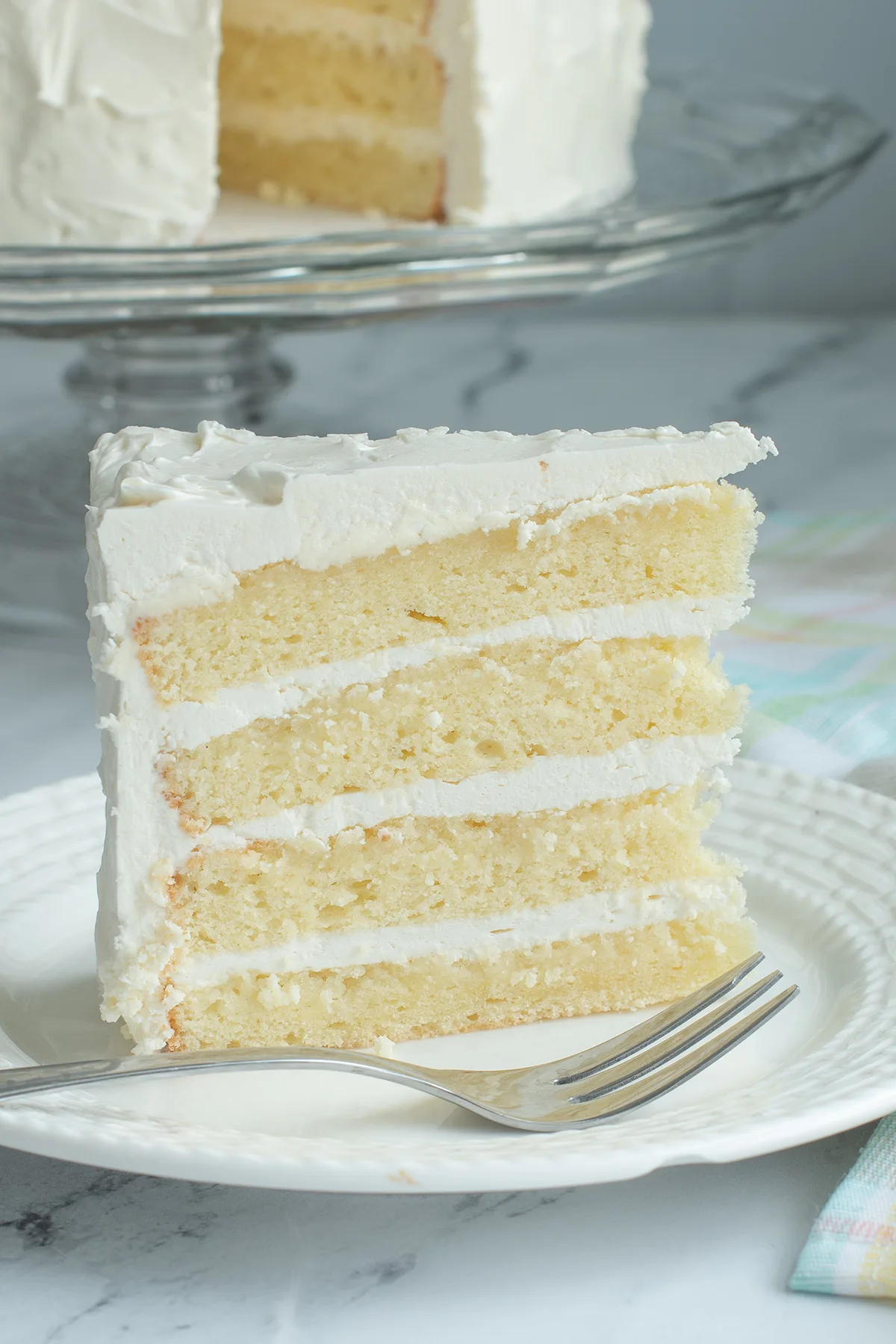
Table of contents
Why this is the best Vanilla Butter Cake Recipe
First of all this is a great recipe because it is a balanced recipe.
Professional bakers use the “Baker’s Percentage” to balance the ingredients in a recipe. With this knowledge I worked for months developing the best vanilla cake.
In fact, this exact recipe was the base for hundreds and hundreds of wedding cakes I sold when I had my wedding cake business.
You can find the percentages for this Vanilla Butter Cake recipe in this all-encompassing post describing how to create the best cake recipes.
Once you have a balanced recipe you need to think about mixing technique.
I make my butter cakes using the “reverse creaming” method of mixing. Reverse creaming makes a cake with a soft and tender crumb. You can see side by side comparisons of reverse and traditional creaming below.
Recipe Ingredients
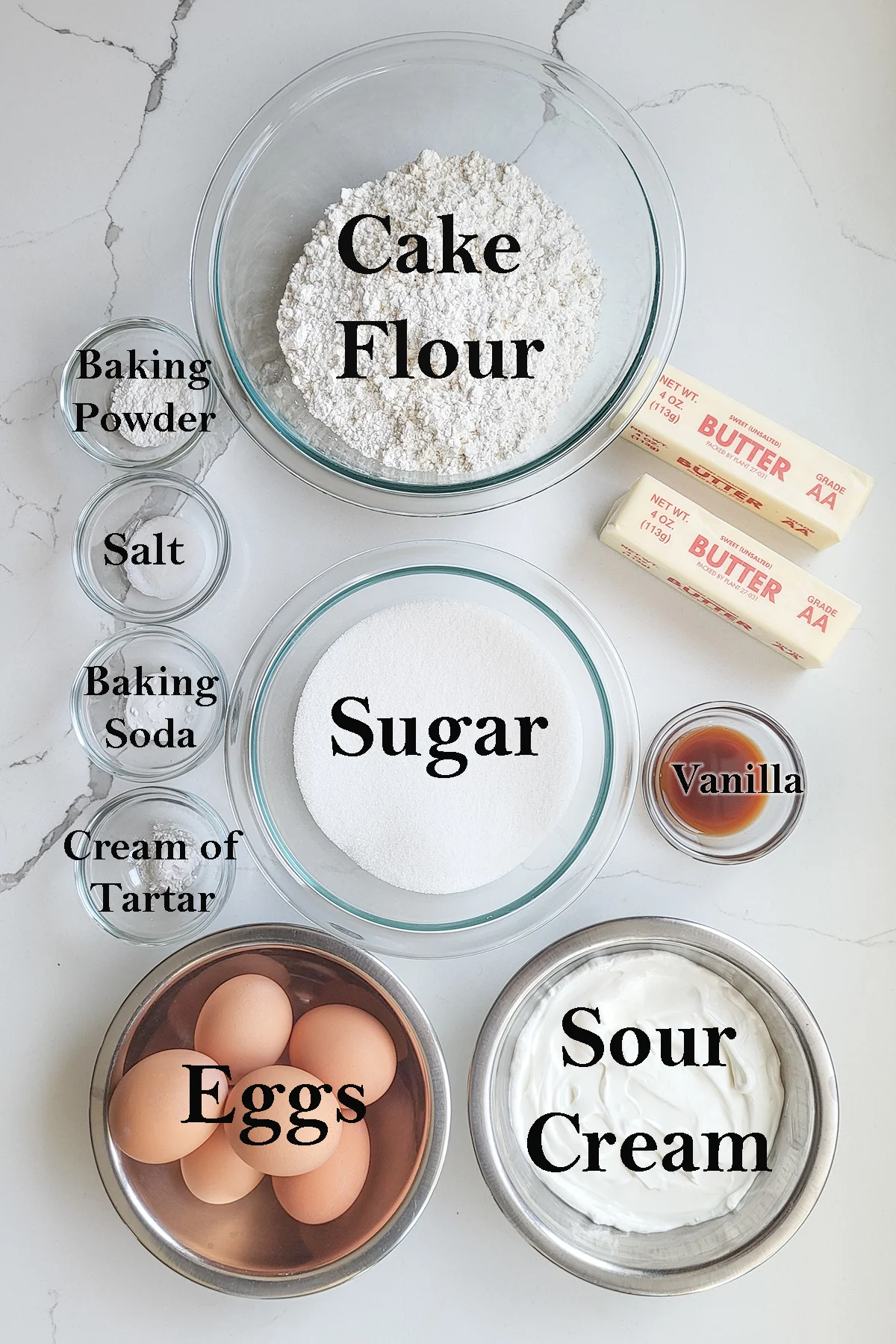
Ingredient Notes
- Cake Flour – Has a lower protein content than all purpose flour so it makes a softer cake. I prefer bleached cake flour. Bleached cake flour is acidic which tenderizes the cake and allows the batter to absorb more liquid for a moister cake.
- Sour Cream – Is used instead of milk as the “liquid” in this batter. Because sour cream is acidic it tenderizes the crumb of the cake and the added fat enriches the batter.
- Eggs – Extra egg yolks in the batter enriches the cake and emulsifies the batter for an even and soft crumb. The whites are whipped and folded into the batter for an extra light and soft cake crumb.
- Cream of Tatar – This acidic ingredient stabilizes the whipped egg whites and acidifies the batter for a softer crumb.
Process Photos
See the recipe card for detailed instructions and measurements.
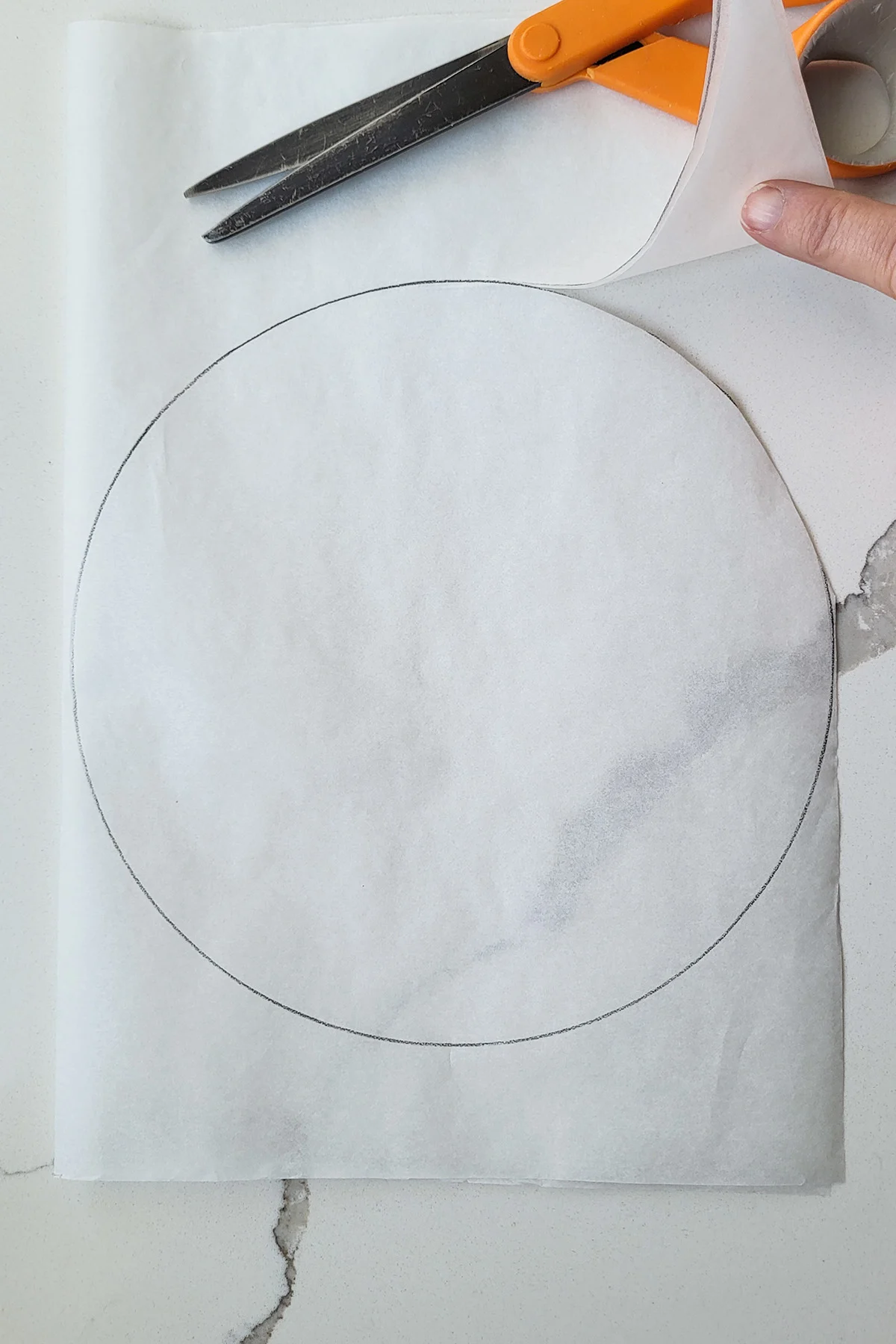
- Draw an 8″ circle on parchment paper using your cake pan as a guide. Cut out two circles and use them to line your cake pans.
- If you don’t have parchment paper butter and flour the bottom of the cake pan only, not the sides.
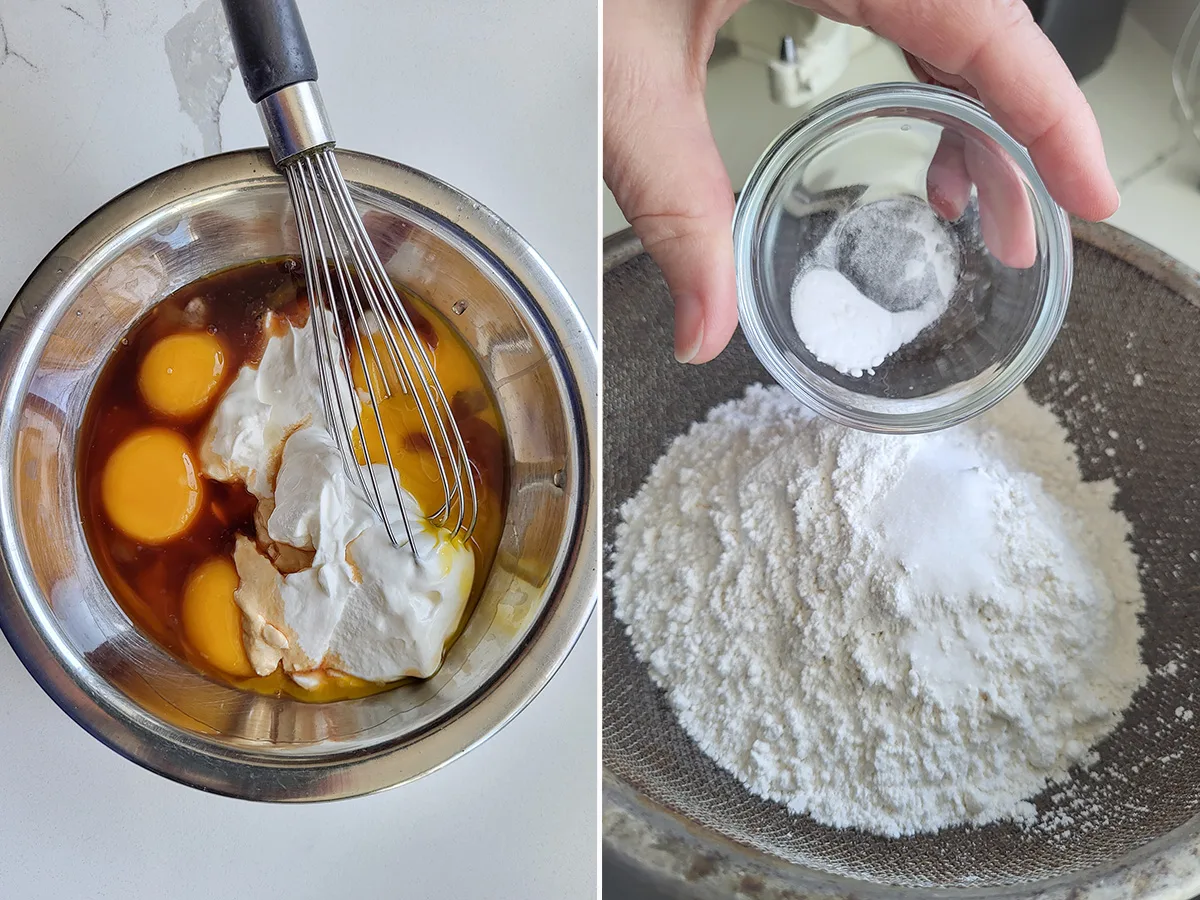
- In a small bowl whisk together the yolks, sour cream and vanilla.
- Sift the dry ingredients into a mixing bowl.
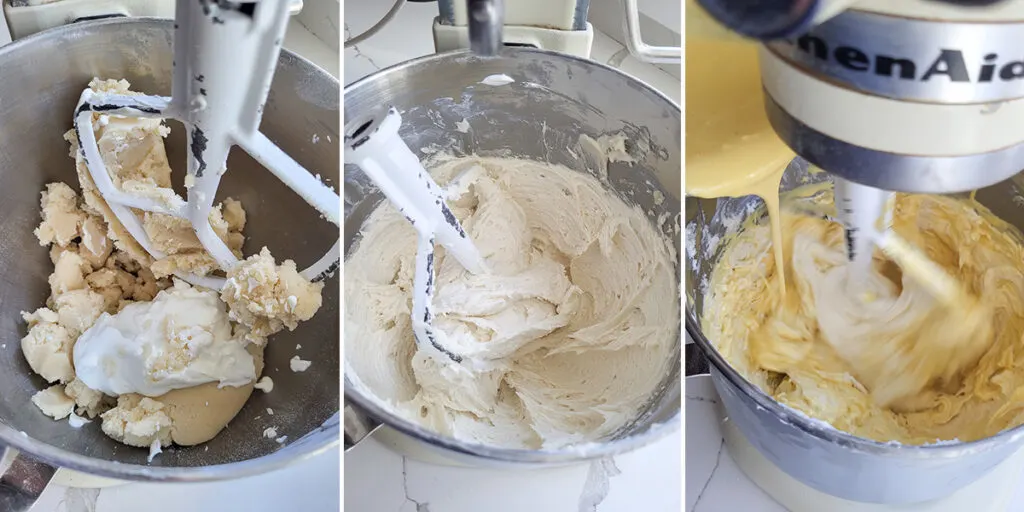
- Mix the dry ingredients on low speed and add the butter. Mix until it forms a thick paste. Add the reserved sour cream.
- Mix the batter on high speed until it is light and aerated. Scrape the bowl and beater.
- With the mixer running on low, add the yolk mixture. Mix until combined.
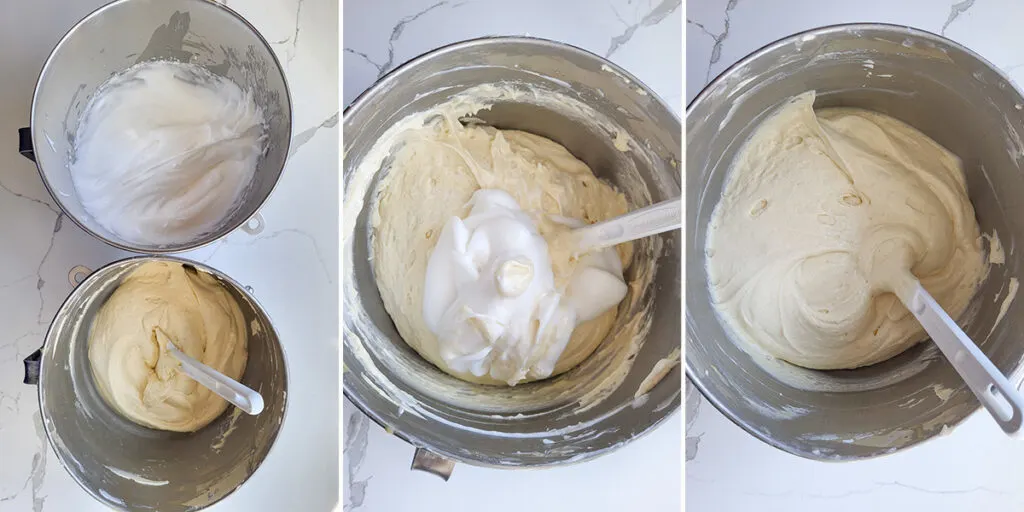
- Whip the whites with the cream of tarter and the remaining sugar. Do no overwhip the whites.
- Fold the whites into the batter in two batches.
- Fold just until there are no streaks of whites.
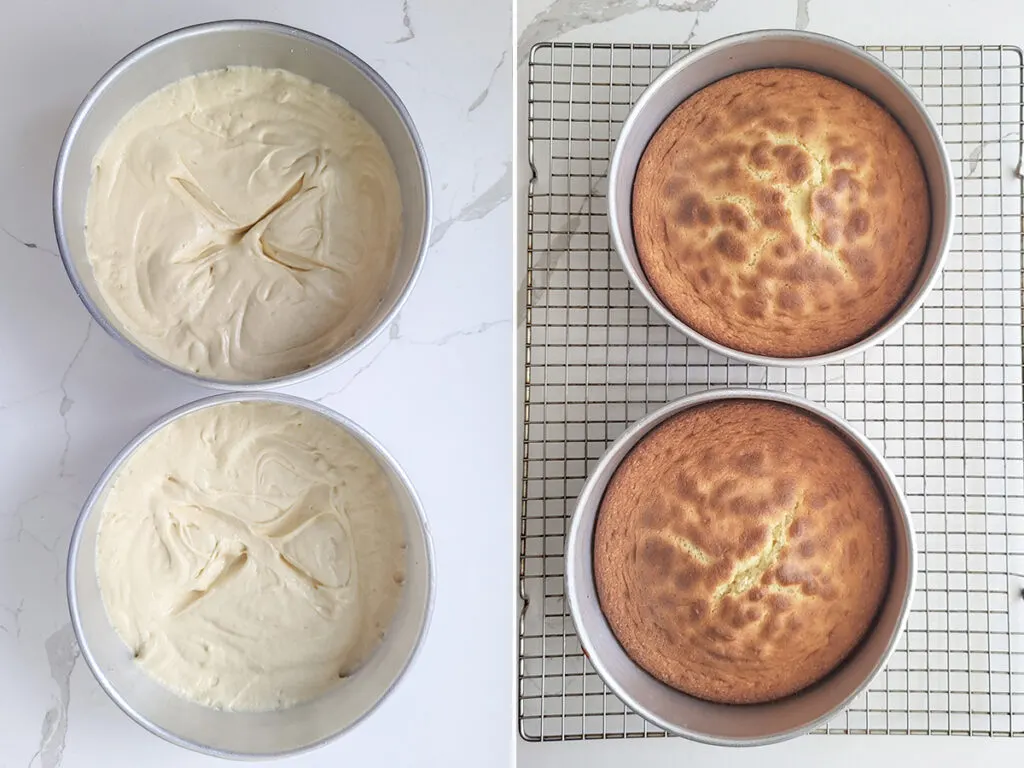
- Evenly divide the batter between the two pans. Smooth to even level then use the tip of your spatula to make an “X” in the center of each cake. This will help the cake rise more evenly in the oven.
- Bake until the center of the cake springs back when lightly pressed. Cool in the pan for 20 minutes then cool completely before icing.
What’s the difference between vanilla cake and yellow cake?
Most people use the terms “vanilla cake” and “yellow cake” interchangeably. Vanilla is the flavoring in the cake. The cake is yellow because of the eggs in the cake.
That being said, not all vanilla cakes are yellow cakes. If you eliminate the egg yolks in the cake and make white cake flavored with vanilla, it too is a vanilla cake.
Reverse Creaming vs. Traditional Creaming
Before posting this recipe I decided to do a quick kitchen experiment to back up my claims that reverse creaming is the way to go for this cake.
I used the same ingredients and mixed them with traditional creaming, reverse creaming and reverse creaming with the eggs separated and the whites whipped and folded in.
There were distinct differences between the three cakes.
- Cake 1 (traditional creaming method) had an open and regular crumb, but was not as tender as I would like and it had a slightly oily mouth-feel.
- Cake 2 (reverse creaming) was very tender, velvety and soft.
- Cake 3 (reverse method with whipped whites) had a slightly irregular but very tender crumb. It was not quite as velvety as cake 2, but it was lighter and quite tender. This was my favorite cake!

Three cakes with the exact same ingredients, but different mixing methods. Left=Traditional Method, Middle=Reverse Creaming, Right=Reverse with Whipped Whites
This is a really great all purpose yellow cake that is tender yet strong enough for stacking or carving. For more information about cake batter, visit the Baking School page.
Frosting your Cake
I like this recipe filled and iced with Italian Meringue Buttercream or Swiss Meringue Buttercream.
American Buttercream is slightly sweeter than meringue buttercream and is also nice with this cake.
Storage
The uniced cake can be stored for 2-3 days at room temperature for up to 2 months in the freezer. Do not refrigerate the cake unless it is filled or iced with a perishable frosting.
More Cake Recipes
Now that you’ve made this recipe what should you do with all the extra egg whites? Check out this collection of recipes that use extra whites for some great ideas.
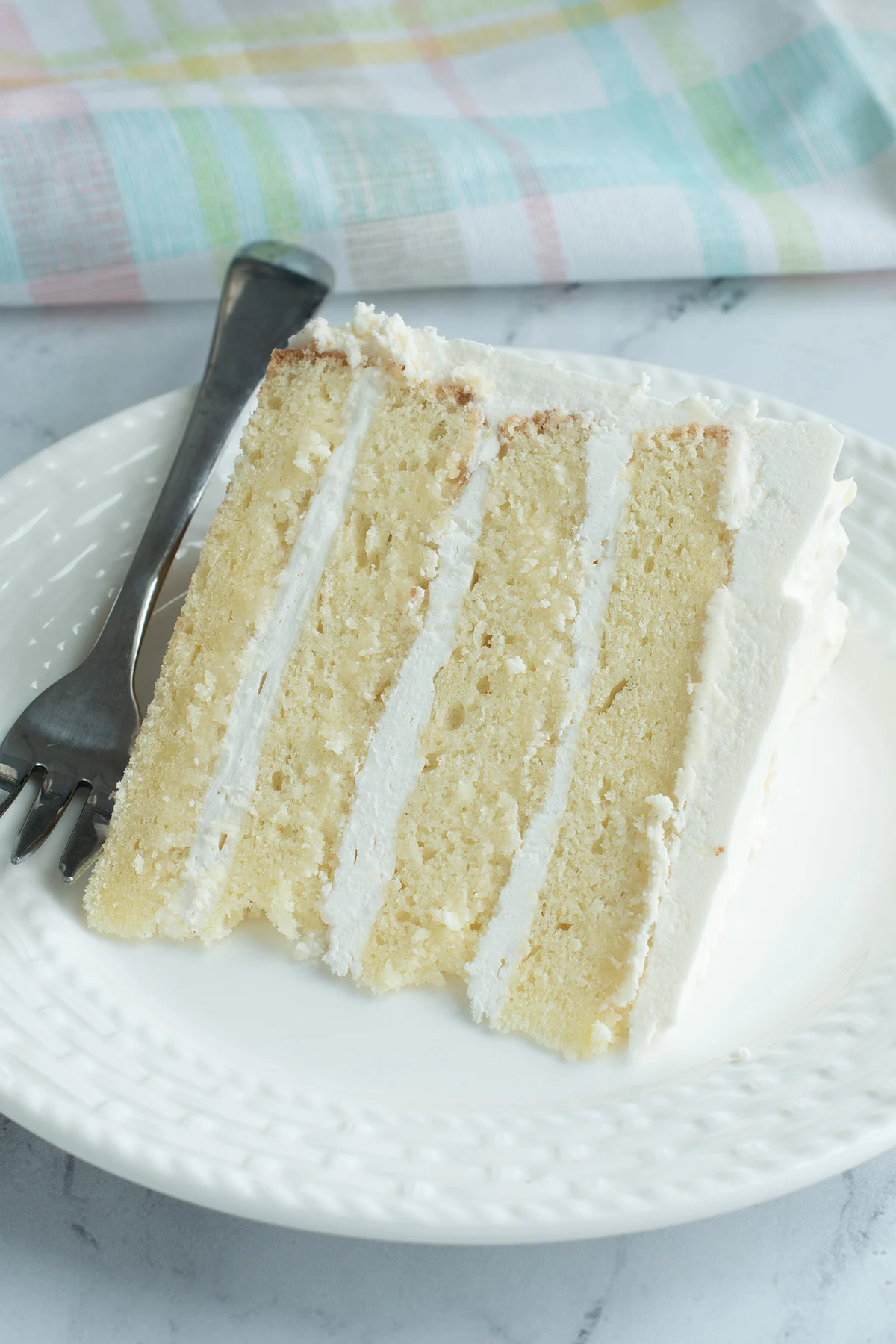
If you love this recipe as much as I do, please consider leaving a 5-star review.
Vanilla Butter Cake Recipe
Ingredients
- 6 large egg yolks (room temperature)
- 8 ounces sour cream (1 cup, room temperature, divided)
- 1 tablespoon vanilla extract
- 12 ounces granulated sugar (1 ½ cups, divided)
- 9 ounces cake flour (2 cups, see note)
- ¾ teaspoon baking powder
- ¾ teaspoon salt
- ¼ teaspoon baking soda
- 8 ounces unsalted butter (room temperature)
- 3 large egg whites (room temperature)
- ¼ teaspoon cream of tarter
Instructions
- Preheat the oven to 350 °F. Line two 8"x3" round cake pans with a circle of parchment paper or butter and flour the bottom of the pans only, not the sides.
- Combine 6 large egg yolks, 1/2 the sour cream and 1 tablespoon vanilla extract in a small bowl, whisk to combine, set aside.
- Into a mixer bowl put 1 ¼ cups of the sugar, sift in 9 ounces cake flour, ¾ teaspoon baking powder, ¼ teaspoon baking soda and ¾ teaspoon salt. Mix on low speed for 10 seconds to distribute the leavening. Add 8 ounces unsalted butter to the flour mixture. Mix on low until the butter is incorporated and the batter looks like a paste. Add the other ½ of the sour cream to the flour and butter mixture. Increase the speed to medium and mix about 3 minutes until the batter lightens in texture. If you're using a hand mixer add another minute or two to the total time.
- Scrape the sides and bottom of the bowl. With the mixer on low, add ½ the egg yolk mixture. Mix until mostly incorporated. Scrape the sides and bottom of the bowl. Add the rest of the egg yolk mixture. Scrape the bowl and mix until incorporated.
- In another bowl, whip 3 large egg whites with ¼ teaspoon cream of tarter on medium high until they form soft peaks. Turn the mixer to medium low and slowly add the remaining ¼ cup of sugar. Turn the mixer to medium high and whip the whites to full peak. Fold the whites into the base in 2 parts, folding just until there are no streaks of egg whites.
- Divide the batter between the 2 pans and spread so it’s level.
- Bake until the center of the cake springs back when lightly pressed or a toothpick inserted into the middle of the cake comes out clean, about 25-30 minutes.
- Cool 10 minutes in the pan and then turn out onto a cooling rack. When fully cooled, wrap in plastic and refrigerate at least 3 hours or overnight before filling and assembling the cake with your favorite frosting.
Would you like to save this recipe?
As an Amazon Associate and member of other affiliate programs, I earn from qualifying purchases.

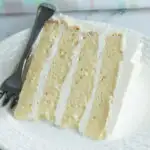
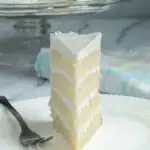
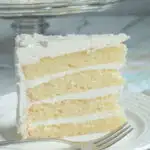
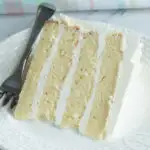





Hi Eileen,
Does this cake stay moist in the fridge? I live in indonesia where is very humid & ppl here are so hung up on putting cakes in fridge. But as u know the cake hardens when cold (its almost inedible). Or do u have any recommendations; using oil in place of spur cream? And how to incorporate that to the recipe? Thanks so very much
The refrigerator will accelerate the staling process. If you can’t keep the cake at room temperature, your better off freezing the cake. Once the cake is filled and iced you can refrigerate it, but it will harden when cold. Take the cake out an hour or two before serving so it has time to come back to room temperature before serving. The sour cream helps keep the cake moist and tender so I would leave it in.
Hi! I am attempting this recipe for my daughters birthday cake. If I’m wanting to do a 8in, 4 layer cake will I need to double this recipe? The picture shows 4 layers, but I didn’t know if the two layers in the recipe are cut in half or if I need to double it to make it the height of the picture. TIA
I always bake two 8″ cakes and then split them to make 4 layers. That’s how the cake in the photo was done. You can visit this post to see how I assemble a 4 layer cake.
Hello! How much sprinkles would you add to this cake to make it a confetti cake?? Thank you! I love your recipes!!
I couldn’t say exactly since I haven’t made it. Maybe start with 1/2 a cup and see how it looks.
Once again, thank you Eileen, for your reply. I went ahead and made my 9″ round cake using 1.25 times the 8″ recipe. I didnt have cake flour but substituted by removing 2 tablespoons of the plain flour and adding 2 tablespoons of cornflour per cup as you suggested. I made 2 cakes – the first one, I forgot to add the sugar until after blending in the butter and I added it then. I thought the first one did not rise very well because of this error. For the second one, I followed the recipe and method to the letter, the only deviation being that since I have loose botttom non stick tins, I lined both bottom and sides with baking parchment but only greased and floured the base. When I checked for ‘doneness’ in the oven towards the end, the cake looked very promising, rising nicely and very soft to the touch. It even looked good when I removed it from the oven but then it began to shrink back. I removed it from the tin to further cool as you suggest. The cooled cake ended up only being 3cm high (loosing about half its initial height) and seemed quite dense to me although it was soft. Is this how it should be or have I done something wrong? The only other observation I could make was, in the first cake, I whipped the eggs whites and sugar ’til they were really thick and glossy but in the second cake I just stopped whipping when the mix was at stiff peaks. Is this difference significant? However, when comparing both cakes, there was very little difference in terms of height and texture. I have taken pics but don’t seem to be able to attach them here.
Hi Maria, I got the photos. A couple of questions and comments. First, no need to put anything on the sides of the pan at all. I only put a round of parchment at the bottom of the pan and don’t butter and flour at all. This allows the sides of the cake to grip the pan as it bakes and get a better rise.
What did your butter look like when you began to mix the batter? I often notice that many bakers interpret “room temperature” butter as very soft and warm. Room temperature butter is pliable, but not melting. You can see the texture of the butter in the video. It’s firm enough to hold it’s shape in cubes. The ideal temperature is between 65°-70°F (18-21c). If the butter is too soft it will affect the outcome of the cake. (You can see an example of how the temp of the butter makes a big difference in this shortcake post.) While room temp butter will coat the flour to prevent gluten formation, if the butter is very, very soft and melty the flour will be unable to mix well with the liquid in the recipe.
Did you watch the recipe video? Did your batter look similar through the process? You say the cake was very soft to the touch towards the end of baking. Did you use the touch test to see if the center was baked? Press the center of the cake and it should spring back.
Hi Eileen,
I want to make your Vanilla Butter cake recipe for my sister’s birthday and want to do it in 9″ round cake tins. How do i increase or modify the recipe, temperature and timings to accommodate that size of cake? Do you have a generic rule or guideline for modifying the recipe for different cake tin sizes. Your knowledge and experience are brilliant and I am loving reading everything to do with baking which I love. Thanks so much.
Maria
If you bake this recipe in 9″ pans the layers will just be a little shorter. I would go ahead and just bake the recipe in the pans. The baking time might be a couple of minutes shorter, but the baking time is always just an estimate. Go more by how the cake looks than the time listed. When you press in the center of the cake it should spring back.
Thank you very much Eileen for the speedy reply. I read on Linseycakes website that I can multiply an 8″ recipe by 1.25 times to achieve the same height of cake. I don’t want the layers to be too thin,so do you think that would work? I was going to ask you about egg sizes but have found the answer above.. I’m going to be brave and get started on this cake!
Sure, you can multiply the recipe. Yes, eggs in my recipes are always large. I’ll try to update that as I see it is needed.